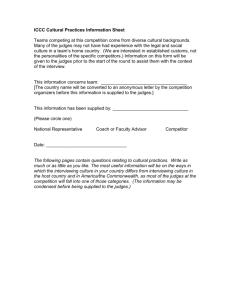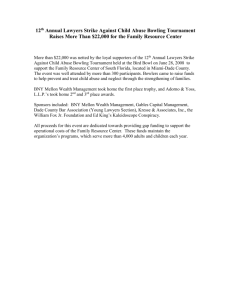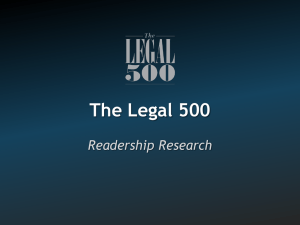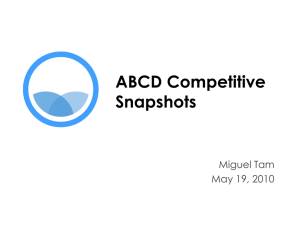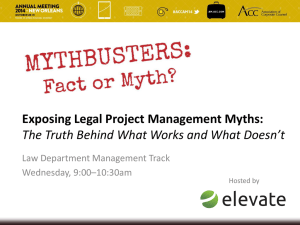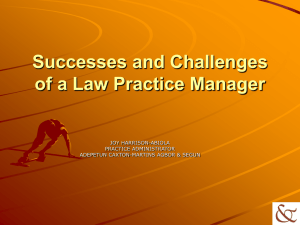Evan Whitton - Productivity Commission
advertisement
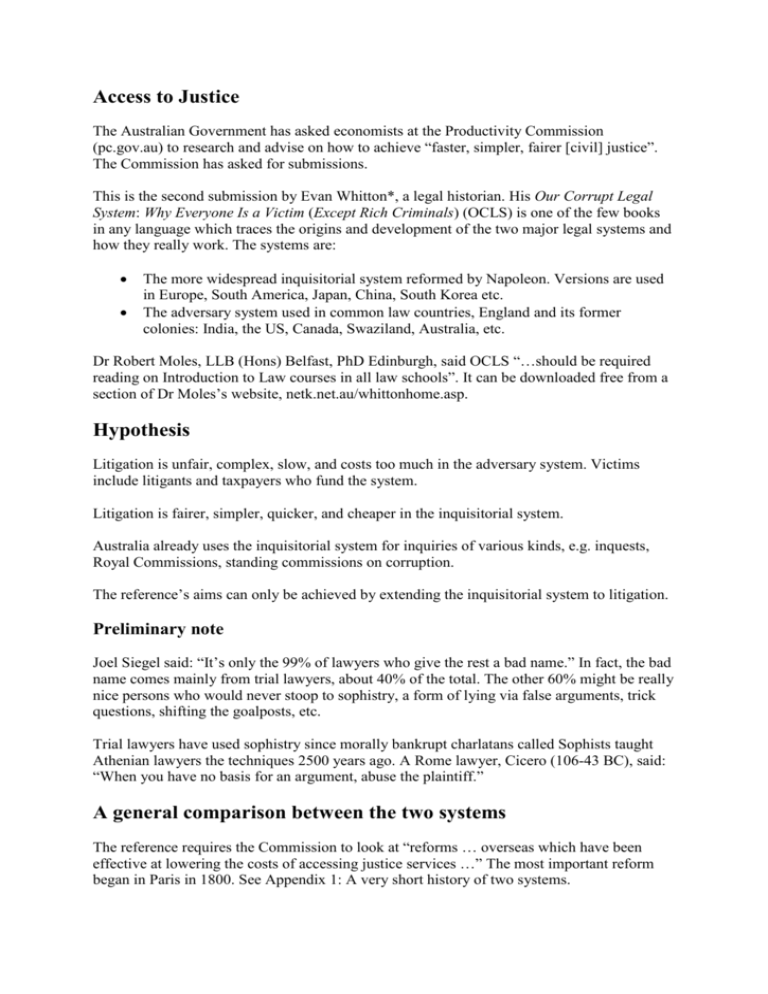
Access to Justice The Australian Government has asked economists at the Productivity Commission (pc.gov.au) to research and advise on how to achieve “faster, simpler, fairer [civil] justice”. The Commission has asked for submissions. This is the second submission by Evan Whitton*, a legal historian. His Our Corrupt Legal System: Why Everyone Is a Victim (Except Rich Criminals) (OCLS) is one of the few books in any language which traces the origins and development of the two major legal systems and how they really work. The systems are: The more widespread inquisitorial system reformed by Napoleon. Versions are used in Europe, South America, Japan, China, South Korea etc. The adversary system used in common law countries, England and its former colonies: India, the US, Canada, Swaziland, Australia, etc. Dr Robert Moles, LLB (Hons) Belfast, PhD Edinburgh, said OCLS “…should be required reading on Introduction to Law courses in all law schools”. It can be downloaded free from a section of Dr Moles’s website, netk.net.au/whittonhome.asp. Hypothesis Litigation is unfair, complex, slow, and costs too much in the adversary system. Victims include litigants and taxpayers who fund the system. Litigation is fairer, simpler, quicker, and cheaper in the inquisitorial system. Australia already uses the inquisitorial system for inquiries of various kinds, e.g. inquests, Royal Commissions, standing commissions on corruption. The reference’s aims can only be achieved by extending the inquisitorial system to litigation. Preliminary note Joel Siegel said: “It’s only the 99% of lawyers who give the rest a bad name.” In fact, the bad name comes mainly from trial lawyers, about 40% of the total. The other 60% might be really nice persons who would never stoop to sophistry, a form of lying via false arguments, trick questions, shifting the goalposts, etc. Trial lawyers have used sophistry since morally bankrupt charlatans called Sophists taught Athenian lawyers the techniques 2500 years ago. A Rome lawyer, Cicero (106-43 BC), said: “When you have no basis for an argument, abuse the plaintiff.” A general comparison between the two systems The reference requires the Commission to look at “reforms … overseas which have been effective at lowering the costs of accessing justice services …” The most important reform began in Paris in 1800. See Appendix 1: A very short history of two systems. It is convenient to examine the Commission’s aims in reverse order: fairer, simpler, faster. Fairer (Justice) The Hon Russell Fox QC researched the two systems for 11 years after he retired from the Australian Federal Court. He wrote in Justice in the 21st Century (Cavendish, 2000): Justice means fairness. Fairness and morality require a search for the truth, otherwise the wrong side may win. Truth means reality (what actually happened). The adversary does not try to find the truth. Lawyers trained in sophistry control evidence and question witnesses. Judges are untrained, uninformed and passive. Jurors are isolated, and do not give reasons for their verdicts. At least 1% of people in prison are innocent (5% in the US). A majority of guilty defendants get off. Civil litigation is a lottery. Judge Fox said the public knows that “justice marches with the truth”. That was largely confirmed by a 2004 report in The [Sydney] Daily Telegraph. It found that 92% of 7,000 readers believe the adversary system is unfair, and that 78% believe it favours criminals. The inquisitorial system tries to find the truth. In France, trained judges control evidence and question witnesses. Lawyers are not allowed to question witnesses directly lest they pollute the truth with sophistry. Jurors and judges sit together and give reasons for their verdicts. The innocent are rarely charged, let alone convicted; 95% of guilty defendants are convicted. Civil litigation is presumably no less accurate. Public confidence in the French and German systems is high, according to evidence at an inquiry into the English criminal system in 1992. Simpler The adversary system has at least 24 mechanisms which defeat truth, including six rules which conceal evidence. (OCLS pp. 156-220.) Some of the rules are difficult to understand, even by lawyers and judges. Jurors do not understand “beyond reasonable doubt”. The French system has no truth-defeating mechanisms, and no rules which conceal evidence. Jurors understand: are we thoroughly convinced? Faster (Cheaper) In the French and German systems, judges on a fixed wage and have no incentive to prolong the process. Most hearings take a day or so in total. (See OCLS pp. 255-258.) In the adversary system, lawyers paid by the day have an incentive to spin the process out. Hearings can take weeks, months or years. That may explain why: Sir John Evelyn wrote in his Diary (26 November 1686) that lawyers’ anecdotes showed they were like “highway thieves”. (See Appendix 1.) Dickens wrote in Bleak House (1853): “The one great principle of the English law is to make business for itself.” H. L. Mencken said in The Baltimore Evening Sun (4 August 1924): “If all the lawyers were hanged tomorrow, and their bones sold to a mah-jongg factory, we would be freer and safer, and our taxes would be reduced by almost half.” Professor Fred Rodell, of Yale law school, wrote in Woe Unto You, Lawyers! (1939): “The legal trade, in short, is nothing but a high-class racket.” Don Vito Corleone said in The Godfather (1969): “A lawyer with his briefcase can steal more than a hundred men with guns.” Oxford law professor Adrian Zuckerman wrote in Civil Justice in Crisis (OUP, 1999): “ … litigation in Germany appears cheap indeed by comparison to common law countries.” Annette Marfording, of the University of NSW law school, compared the German and NSW systems in Civil Litigation in NSW: Empirical and Analytical Comparisons with Germany (2010). She said the NSW system tends to enhance, and the German system tends to reduce, “complexity, delay, and litigation costs”. Marfording said: “ … the difference in lawyers’ fees appears astounding.” In cases involving about $120,000, the NSW lawyers’ fees were $36,000 (30% of the value at stake); the German lawyers’ fees were $2000 (1.8%). German court files “included complete and accurate data on all legal costs of the proceedings including the fees for both parties’ lawyers, court fees and payments to experts and witnesses”. NSW court files were incomplete on “court fees and had no information on the other above aspects of litigation costs, most significantly on the legal fees charged by the litigants’ lawyers”. Suggested recommendation. Australian court files to be as transparent and complete as those in Germany. Five areas of civil law that need major reform The Commission will have to assess particular areas of civil law to see if they could be faster (and cheaper), simpler, or fairer (more just). In the following five areas, the Commission may find that all could be much cheaper, that some allow lawyers to deliberately steal from their clients, and that libel (at least) perverts justice. Pleadings (See OCLS pp. 117-119.) Pleadings are supposed to narrow the issues. In France and Germany, it takes the judge and lawyers an hour or so of oral discussion to agree on the issues. England used a similar system until 1460, when judges began to let lawyers send written pleadings to each other. That eliminated judges and began the adversary system. Written pleadings can go back and forth for months: statement of claim, defence, reply, rejoinder, surrejoinder, rebutter, surrebutter, counter-claim … They are also largely useless because, in line with the system’s attitude to truth, written pleadings have never had to be true. In 1998, the West Australian Law Reform Commission recommended changing to a procedure which “resembles most closely that prevailing in Germany”. That Commission said legislation was not needed; judges could make the change themselves. The change has not happened. Suggested recommendations: Legislation to make pleadings conform to the German model. Failing that, lawyers to be on oath when writing pleadings. See Appendix 2 Discovery (See OCLS pp. 119-123.) In France, “discovery” of documents is almost unknown; if the investigating judge wants a relevant document, he sends for it. A few words by an English judge, William Brett, in 1882 eliminated relevance and extended discovery for months or years. In a case about Peruvian bird excreta, he said any document is discoverable if it might, directly or indirectly, lead to a “train of inquiry” which might help a lawyer’s case or hinder his adversary’s. (Emphasis added.) Lawyers can thus ask the other side to “discover” and hand over hundreds, thousands or millions of documents. Perhaps 20 are mentioned at subsequent trials. The process is thus largely useless, but clients have to pay the cost of collating, analysing, copying, filing, and storing the documents. The Economist reported in 1992 that discovery accounts for 60% of the time and money spent on US lawsuits, and that in 1988 a Lou Harris survey of lawyers revealed: “In an IBM antitrust [monopoly] suit, discovery took five years and produced 64 million pages of documents.” “A partner at a big [US] law firm bragged to law school students about a long antitrust case: ‘My firm’s meter was running all the time – every month for 14 years’.” “… a big majority of litigators for both plaintiffs and defendants said that discovery is used as a weapon to increase a trial’s cost and delay to the other side (nearly half said lawyers use it to drive up their own charges).” Those admissions indicate that at least some US lawyers even use discovery to steal from their own clients. Suggested recommendation. Judges to handle discovery of relevant documents. Negligence (See OCLS pp. 123-28.) Lawyers like the word “reasonable”; it can mean anything. Lord Atkin opened the negligence floodgates in Donoghue v Stevenson (1932), an appeal concerning an alleged snail in a bottle of ginger beer. Atkin said: “The rule that you are to love your neighbour becomes in law, you must not injure your neighbour … You must take reasonable care to avoid acts and omissions which you can reasonably foresee would be likely to injure your neighbour. Who then, in law, is my neighbour? The answer seems to be – persons who are so closely and directly affected by my acts that I ought reasonably to have them in contemplation …. (Emphasis added.) Lawyers get up to half the payouts from negligence cases. Judge Russell Fox said: “The simple fact is that no one can define negligence, nor in most cases is it possible to form an accurate view of the facts.” Suggested recommendation. Legislation for no-fault compensation. Libel (See OCLS pp. 128-139.) A bias in favour of one side encourages people to sue; the sued have to pay lawyers to defend them; and the bias tends to pervert justice, a crime for which the maximum penalty is 14 years, if a law could be imprisoned. Criminal law is biased in favour of defendants; libel law is biased against defendants. Libel law began in 1275 to deter slurs about the “magnates”, most of whom were organised criminals. After Defoe invented modern journalism on 19 February 1704, libel law was reinforced to protect corrupt politicians and the corrupt judges they appointed, e.g. Prime Minister Robert Walpole, his bagman, the Duke of Newcastle, and Chief Justice Mansfield. Mansfield ruled: “The greater the truth, the greater the libel.” Libel law also made a lot of money for lawyers since he 19th century. Bias. The bias in favour of plaintiffs comes from: False presumptions. Slurs are always intentional, always cause damage, and are always false. There is thus a presumption of guilt for defendants. The onus of proof: In criminal cases, the defendant does not have to prove anything. In libel cases, the onus of proof is on the defendant. Concealed evidence. Witnesses for the defendant can say the plaintiff ’s reputation is not good, but cannot say why. The US Supreme Court unanimously ended the bias in New York Times v Sullivan (1964). Justice William Brennan wrote the lead opinion which abolished the false presumptions and put the onus on the plaintiff. Concurring were Chief Justice Earl Warren, and Justices Hugo Black, William O. Douglas, Tom Clark, John Harlan, Potter Stewart, Byron White, and Arthur Goldberg. By 1991, the number of libel actions pending throughout the entire United States was a little less than half the 142 libel actions pending in Sydney. The bias remains in common law countries outside the US. It means that media organisations cannot properly do their job, i.e. tell the customers what is really going on. It seems fair to say that those which do not campaign to make libel law fair: 1) Betray their customers, 2) Get what they deserve. Judges presumably believe the rule of precedent (see Appendix 1) does not allow them to remove the bias and consequent perversions of justice. They would have more credibility if they were to urge Parliament to end the bias. Cost. An Oxford University study in 2008 found that libel cases in England are about 140 times more costly than in Europe, where trained judges dispose of libel cases in a day or so. The McLibel case, McDonald's v Steel & Morris, ran for 10 years. Lord (as he now is) David Pannick QC said: “The McLibel case has achieved what many lawyers thought impossible: to lower further the reputation of our law in the minds of all right thinking people.” The case concerned a pamphlet critical of the activities of the fast food company. McDonald’s had a partial victory and was awarded damages of £60,000 in 1997. In 2005, the European Court of Human Rights ruled that the defendants did not get a fair trial, and that they should have been protected by freedom of expression. Suggested recommendation. At a minimum, legislation to remove the bias. Class actions (OCLS pp. 147-153.) Class actions are a product of an increase in the number of lawyers in the US from the 1970s. The actions are nominally a way of getting some compensation for the poor and powerless, but up to 50% of the proceeds went to lawyers. Former Justice Russell Fox showed how class actions relating to asbestos, tobacco, intrauterine devices, breast implants, etc. can be dealt with at minimum cost. He wrote: “… the vital evidence usually consists of what information the defendant had at any relevant time and what it should have done as a result … there should, absent an admission, be a single inquiry, preferably a judicial inquiry, into the information reaching the manufacturer or producer and as to the causal connection. “The inquirer(s) will be assisted by counsel, but not a host of counsel. It would probably be as well to have two laymen, with a judge, or even two judges and three laymen, because the results will be available as evidence in any action. “The vital matter will be to search effectively the files of the manufacturer, and ascertain the knowledge of its directors and employees, with no legal excuse allowed to stand in the way. The other matter, of causation, will inevitably be the subject of scientific evidence.” Recommendation. Legislation to adopt Judge Fox’s approach. * * * Legal aid. (OCLS 164-65.) This is a difficult area. Legal aid was invented in England in 1949. An English lawyer, Arthur Marriott QC, told a Sydney audience in 2005: “Perhaps the main impact of the [Legal Aid] Act was the extraordinary growth in the numbers of practising lawyers.” Legal aid in criminal cases is largely a fraud on taxpayers and the general public because almost all defendants are guilty. They are entitled to a defence, but legal aid lawyers should not be allowed to use public moneys to pervert justice. In Queensland and NSW, legal aid lawyers get more money to try to get criminals off than the Director of Public Prosecutions gets to try to convict them. The Queensland DPP’s budget in 2008 was about $30 million; the legal aid budget was $101.3 million. The NSW DPP’s budget for 2007-08 was $96 million; the legal aid budget was $214 million. In 2009, the DPP had to drop some prosecutions, and could not provide lawyers for some courts. An increase in civil legal aid would not, on its own, address the reference’s requirements for faster, simpler, fairer justice; it would only achieve more money for lawyers. Recommendation. Legal aid to be available for the poor and middling, contingent on systemic change to allow trained judges to deal with cases in a day or so. Appendix 1. A very short history of two systems The Productivity Commission will not fully understand the civil system without some knowledge of the origins and development of the two systems. Law schools cannot help much; they generally teach what the common law IS, not where it came from, let alone anything about the inquisitorial system. See OCLS pp. 22-68. Eliot on chance: Footfalls echo in the memory Down the passage we did not take Towards the door we never opened Into the rose garden. Both systems are the products of chance, one in 1166 the other in 1800. The English trade of authority happened to be totally corrupt when the common law began in 1166. Every public office, from Chancellor down, was for sale; investors in turn extorted bribes from people who dealt with the office. Extorting judges probably used lawyers as cut-outs, as they did in Chicago quite recently: 20 judges and 50 of their bagmen went to prison. Judging is, or should be, different from lawyering. A corrupt judge-lawyer relationship in the 12th century may explain why common law judges have never been trained as judges separately from lawyers. European courts adopted an inquisitorial system after a conference in 1215, but the halfdozen English judges rejected it in 1219. Corruption is simpler if you don’t have to find the truth, but the nominal excuse was “an insular dislike of things foreign”, i.e. Wogs begin at Calais. (In 1993, an inquiry into the English criminal system again rejected the truth-seeking system, and gave a similar reason: “Every system is the product of a distinct history and culture, and the more different the history and culture from our own, the greater must be the danger that an attempted transplant must fail.” That ignored the fact that England uses the inquisitorial system for inquiries of various kinds.) European judges perverted justice for five centuries. They believed – like recent US Governments – that torture is a reliable way of finding the truth. It was not until the 18th century that monarchs told judges to stop torturing suspects. By 1350, lawyer-politicians were the “dominant interest” in Parliament. They effectively remain an oligarchy in many English-speaking legislatures; hence the difficulty of changing the system. Lawyers are 0.2% of the US population and 43% of Congress. Chief Judge Richard Posner said judges and lawyers (including academics from the late 18th century) have always been a cartel. Chief Judge Dennis Jacobs and law professor Ben Barton say judges favour lawyers’ financial interests. The order of Serjeants-at-Law became, in effect, the cartel. Professor Theodore Plucknett wrote: “In the course of the 14th century the Serjeants [became] a close guild in complete control of the legal profession … By the close of the 14th century the judges are all members of the order of Serjeants, and Serjeants alone can be heard in the principal court, that of Common Pleas.” That court heard civil cases. By 1400, the Serjeants thus had a monopoly of work in the civil courts, and a monopoly of appointment as judges. They presumably paid huge bribes to the Lord Chancellor for appointment; Plucknett said their wealth in the 14th century “must have been enormous”. Fewer than 1000 Serjeants were appointed from about 1400 until their monopoly ended in 1846, i.e. a little more than two a year. Plucknett said the judge and lawyer Serjeants lived together during term time in Serjeants’ Inns in the Middle Ages, “and discussed their cases informally together simply as Serjeants, without distinction between those on the bench and those at the bar”. They presumably also divided the bribes and conspired how to increase profits. It may be that discussions in the Serjeants’ Inns led to the adversary system, i.e. judge-Serjeants would let lawyer-Serjeants take over control of the civil process, which is where the money was and is. The Commission might consider whether three items tend to confirm the continued existence of a judge-lawyer cartel, conscious or otherwise. And if it does exist, whether it can be dismantled by training judges (separately from lawyers) in techniques of searching for the truth. 1. The adversary system and the rule of lawyers Complaints about the “rule of lawyers” have been increasing since 2003, when a US jurist, Walter K. Olson, published The Rule of Lawyers: How the New Litigation Elite Threatens America’s Rule of Law. A US media proprietor, Rupert Murdoch, said in Australia on 31 October 2013: “You can't have the rule of law if the courts aren't free and independent, or if you have lawyers running amok as they do in the American system. We cannot allow the rule of law to become the rule of lawyers!” Mr Murdoch is seriously misinformed: the rule of law has always been a myth in England and its colonies; there is doubt that judges are independent of lawyers; and the rule of lawyers has obtained for 5 1/2 centuries. Judges were in charge of civil evidence for three centuries (and of criminal evidence for more than five). The process was fast and simple, if not necessarily fair and just. In 1460, Serjeants began to take over control of the civil evidence. That began the adversary system and the rule of lawyers. The Serjeants were able to spin the process out and increase their profits exponentially. Having made their pile, they could retire to sit on a bench and try to stay awake; Lord Thankerton knitted. Four Serjeants told Sir John Evelyn on 26 November 1686 how they thieved from their clients. He wrote in his diary: “I din’d at my L. Chancelors, where being 3 other Serjeants at Law, after dinner being cherefull and free, they told their severall stories, how long they had detained their clients in tedious processes, by their tricks, as if so many highway thieves should have met and discovered the severall purses they had taken.” 2. Disputed wills The Lord Chancellor’s Chancery Court dealt with disputed wills. About 1650, someone – possibly Bulstrode Whitleock, Lord Chancellor 1649-53 – decided that deceased estates, not clients, would pay the fees of ALL lawyers who made claims. Two things happened: will cases were not finalised for decades; lawyers looted the estates. Jennens v Jennens (the model for Dickens’ Jarndyce v Jarndyce) concerned an estate worth $1.5 billion today. The case ran from 1798 until the estate was empty in 1915. In NSW, lawyers are still paid from deceased estates in will cases. Suggested recommendation. Lawyers to be paid by clients in cases of disputed wills. 3. New truth-defeating mechanisms Lawyers first began to defend criminals in 1695. Conviction was fairly certain: the system then had only one rule which concealed evidence and four other truth-defeating mechanisms. For much of the next century, few accused hired lawyers. Since 1800, judges have invented five more rules which conceal evidence – George Orwell said: “The omission is the most powerful form of lie.” – and 14 other truth-defeating mechanisms. (As noted above, OCLS has details of the 24 mechanisms at pp. 156-220.) The mechanisms necessarily tend to pervert justice, but they give rich criminals a better-than even chance of getting off, and so encourage them to pay lawyers. Note on precedent. David Pannick QC (Lord Pannick from 2008) wrote in Judges (Oxford 1988): “There are many things wrong with the English legal system. A large proportion of them can be explained by our reverence for the doctrine of precedent.” Precedent is a product of the second half of the 19th century. It obliges judges to adhere to previous rulings even if they pervert justice, e.g. an 1894 rule which protects organised criminals, serial rapists, and clerics who commit sex crimes on children. Napoleon reforms the inquisitorial system European judges had been forced to give up torture in the 18th century, but the inquisitorial system was still a shambles of local practices and interpretations. Late in the century, lawyer-politicians were heavily represented in the corrupt French legislature. Napoleon told his generals on Saturday, 9 November 1799: “We must get rid of these lawyers.” Next day, 500 politicians at the Orangerie at St Cloud planned to have Napoleon guillotined, but his cavalry general, Joachim Murat, lined up a column of grenadiers; ordered the drums to beat; marched his men into the Orangerie; and gave the order: “Throw me these blighters out of the window.” That was the end of the lawyer-politicians, but it would have meant nothing for the law except for the merest of chances at the Battle of Chicken Marengo on Saturday 12 June 1800. A fluke of timing blew away the second coalition (of seven) which England financed against France, and gave Napoleon a breathing space of three years. He used the time to begin work on his monument, reform of the inquisitorial system. He and his colleagues, including lawyers, had an advantage: they knew that justice means truth. They built on that to produce a system that is faster, simpler and fairer than ours. Details of Marengo and Napoleon’s approach to reform are at pp. 62-68 of OCLS. There was an unfortunate chance in the War of the Third Coalition (1805): Admiral Villeneuve had did not follow Napoleon’s instructions. Had he done so, France would probably have successfully invaded England, and Australia would already use the inquisitorial system for all procedures, not just inquiries. Appendix 2. Why lawyers and judges should take the oath Perjury is lying under oath. In what is presumably an unintentional joke, the Wikipedia says: “Perjury is considered a serious offence as it can be used to usurp the power of the court, resulting in miscarriages of justice.” The maximum penalty for perjury can be as high as 20 years in prison. A US lawyer, Charles Curtis, said a lawyer’s function “is to lie for his client … He is required to make statements as well as arguments which he does not believe in”. However, legal ethics give lawyers permission to lie and pervert justice. Hofstra law professor Monroe Freedman, who received the American Bar Association’s highest award for his writings on ethics, wrote in 2006: “ ... there are circumstances in which a lawyer can ethically make a false statement of fact to a tribunal; can ethically make a false statement of material fact to a third person; and can ethically engage in conduct involving dishonesty, fraud, deceit, or misrepresentation.” A Sydney lawyer, Stuart Littlemore, stated ethics accurately when Andrew Denton interviewed him on Channel 7 in October 1995: Denton: It's a classic question. If you're in a situation where you are defending someone who you yourself believe not to be innocent - can you continue to defend them? Littlemore: Well, they're the best cases; I mean, you really feel you've done something when you get the guilty off. Anyone can get an innocent person off; I mean they shouldn't be on trial. But the guilty - that's the challenge. Denton: Don’t you in some sense share in their guilt? Littlemore: Not at all. Judges can first make a decision and then cobble together reasons to justify it. US law professor Peter Ben Friedman said: “It is almost a cliché that judges reach personal … decisions … before coming up with the legal rationalizations for those … decisions.” US lawyer Alan Dershowitz said: “… lying, distortion, and other forms of intellectual dishonesty are endemic among judges …The courtroom oath – ‘to tell the truth, the whole truth and nothing but the truth’ – is applicable only to witnesses. Defense attorneys, prosecutors and judges don’t take this oath – they couldn’t!” Subornation of perjury is the crime of “procuring, persuading, or inducing another person to give false testimony”. Lawyers and judges can induce a witness to perjure herself against her will. In Legal Reasoning, jurist Christopher Enright notes a witness trying to give an explanation to a particular question, but the lawyer and the judge insist on a Yes or No answer. Enright says this could deprive the court of relevant evidence, and the witness would not be true to the oath to tell the whole truth. He asks: “In this case, is the witness guilty of the criminal offence of perjury? Are the lawyer and the judge guilty as accessories to the perjury of the witness?” Note. In France, witnesses give evidence in narrative form. There is no: Answer Yes or No: Have you stopped beating your husband? There is a subtle technique of cross-examination in which a lawyer asks a series of questions with minute variations, but all require the answer Yes. The judge presumably knows what the lawyer is up to, but does not intervene. Finally, the 90 degree shift is complete, and the witness is forced to answer Yes when she wants to say no. If judges were on oath, several Australian High Court judges would have spent long terms in prison. Section 260 of the 1936 Tax Act said: “Contracts to evade tax … shall … be absolutely void.” In 1957, Owen Dixon, Dud Williams, Eddie McTiernan, Frank Kitto, and Alan Taylor brazenly usurped the power of the Parliament. They effectively ruled that absolutely does not mean absolutely; there could be exceptions. Their sophistry opened the tax evasion floodgates for tax lawyers and their clients; pay-asyou earn taxpayers had to make up the losses. Rulings from 1970 to 1978 robbed the Tax Office of some $11 billion at today’s rates. In Curran (1974), Garfield Barwick, Harry Gibbs and Doug Menzies even effectively said a profit of $2782 was a loss of $186,046. Reporters are not equipped to detect sophistry used by lawyers when they question witnesses, or by judges in the cobbling-together process, or most judicial lies in the end product. And even if they could, libel law would prevent them reporting it. Recommendations. 1. Judges and lawyers to take the oath at the beginning of each case. 2. An office of Sophistryfinder-General to be set up to report sophistry. 3. A special court to hear perjury charges against lawyers and judges. Appendix 3. Are common lawyers guilty of the crime of wilful blindness? It is usually necessary to prove a suspect had a guilty mind (mens rea) as well as committing a guilty act (actus reus). For example, the law has held since 1843 that you cannot be guilty of murder if you were mad. (Some 50 years ago, judges began to accept lawyers’ arguments that if their clients were only a bit mad, they might be only be a bit guilty.) Common lawyers, including judges and academics, could give several reason why they cannot have a guilty mind about the system’s tendency to pervert justice. Thus: Law schools have taught students for 200 years that the adversary system is the greatest ever devised by the mind of man. The first academic, a serial liar named Blackstone, even said it was “dictated by God Himself”. Some judges and lawyers have said it is the Rolls Royce of legal systems. Anything can be rationalised. John Bryson, barrister and author of a book on the Lindy Chamberlain case, Evil Angels, told law students: “First, we believe as we wish to believe, always, always, always. Second, the passion with which we believe rises in absolute proportion to the importance to us of success in our current enterprise.” Professor Bent Flyvbjerg put it this way: “Power often finds deception, self-deception, lies, and rationalizations more useful for its purposes than truth and rationality, [but that] does not necessarily imply dishonesty. It is not unusual to find individuals, organizations, and whole societies actually believing their own rationalizations.” And lawyers and judges could rightly object if attempts were made to use the trepanning instrument to see if they had guilty minds. On the other hand, prosecutors could use wilful blindness principles to prove a guilty mind. Margaret Heffernan, author of Wilful Blindness, says wilful blindness has been a crime for more than 150 years. Chief Justice Sir Alexander Cockburn said in Regina v Sleep (1861) that the accused could be convicted of possessing government property if “the jury found that either he knew the goods came from government stores, or had ‘wilfully shut his eyes to the fact’.” Heffernan defines wilful blindness as: “If there is knowledge that you could have had and should have had but chose not to have, you are still responsible … Cases of wilful blindness aren't about hindsight. They feature contemporaneous information that was available but ignored.” The Commission might assess whether or not some of the following indicate wilful blindness to reality: Truth. If 99.8% of Australians know that “justice marches with the truth”, why cannot the 0.2% who are judges and lawyers? Refusal to ask clients if they are guilty. Socioligist Lisa J. McIntyre wrote in The Public Defender: “ … most public defenders don’t ask whether their clients ‘did it.’ They claim it’s irrelevant, but some seem afraid their clients will tell the truth.” The theory of the case. The theory says our guy didn’t do it sowe have to look elsewhere. There is the SODDIT defence (some other dude did it), or the goalposts can be shifted to the victim, the police, etc. Lawyer Jeffrey Toobin wrote: “The most common quandary of the criminal defense attorney [is] what to do about a guilty client?” He said O.J. Simpson’s lawyers knew he was guilty of murder “from the start … The answer, they decided, was race … [They] sought to invent … an alternative reality, for the events of June 12, 1994. This fictional version … posited that Simpson was the victim of a wideranging conspiracy of racist law enforcement officials who had fabricated and planted evidence in order to frame him for a crime he did not commit”. John Dobies, a Sydney lawyer, pilloried the theory of the case in what he called The Polar Bear Defence. If there were scratches on the body of a murder victim in Sydney, a polar bear may have been responsible. Witnesses sought would be expert on the incidence of polar bears in Sydney, and others who saw a polar bear that day. Recommendation: 1. An office to identify wilful blindness, if any. 2. A special court to hear cases of wilful blindness by judges and lawyers. Victims of the system It is now apparent that many citizens are multiple victims of the system: 1. Taxpayers obliged to pay the wages of lawyer-politicians, judges, police, prosecutors, legal aid lawyers, legal bureaucrats, court staff, etc. 2. Innocent people in prison, victims of crime and their families, litigants, doctors, people in business and industry, the media (outside the US), police, lawyers and judges apparently unaware they are part of a racket, etc. 3. Pay-as-you-earn taxpayers who have to pay more because judicial sophistry has facilitated tax evasion by corporations and self-employed. 4. Taxpayers who subsidise serial litigators and their lawyers because litigation is a tax deduction for businesses. How to change to a truth-seeking system The public knows the common law has failed as a system of justice. So why has it not been changed? The answer seems to be that lawyer-politicians have had the ultimate power to block change for more than seven centuries. The Murat Solution is probably impractical, and the Mencken Solution may seem overly severe. A more humane solution would be to reduce lawyers’ percentage of the legislature to their percentage of the population: 0.2%. It may take some time, but lawyer-politicians would not be hugely missed. A 2013 Reader’s Digest Australia poll of trusted occupations found that judges and lawyers are less trusted than police, bus drivers, hairdressers, waiters, and cleaners, and that politicians, including lawyer-politicians, placed 49th (second last) on the trusted list. Suggested recommendation: Vote 1: Anyone but a lawyer.
